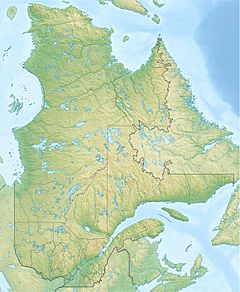Ronald River facts for kids
Quick facts for kids Ronald River |
|
|---|---|
| Native name | Rivière Ronald |
| Country | Canada |
| Province | Quebec |
| Admin region | Côte-Nord |
| Municipality | Sept-Rivières |
| Physical characteristics | |
| Main source | Lac Fraser 50°16′23″N 67°13′35″W / 50.272993°N 67.226270°W |
| River mouth | MacDonald River 50°10′22″N 67°15′39″W / 50.17288°N 67.26093°W |
| Length | 21 kilometres (13 mi) |
| Basin features | |
| River system | Aux Rochers River |
| Basin size | 128 square kilometres (49 sq mi) |
The Ronald River (also known as Rivière Ronald in French) is a river located in the Côte-Nord region of Quebec, Canada. It flows into the MacDonald River.
Where is the Ronald River?
The Ronald River is found in the Sept-Rivières Regional County Municipality in Quebec, Canada. This area is known for its cool, subarctic climate. The river is a branch of the MacDonald River, which then flows into the larger Rivière aux Rochers.
The Ronald River is an important home for atlantic salmon. It is also planned to be entirely within the new Lake Walker National Park.
The area drained by the river, called its basin, covers about 128 square kilometers (49 square miles). The river valley itself is about 21 kilometers (13 miles) long. It gets its water from lakes like Desrosiers, Gaudreault, Rosaire, and Fraser. Lac Fraser is located at the very start of the river valley. The highest part of the river is about 256 meters (840 feet) above sea level. You can reach the river by a 2.5-kilometer (1.6-mile) trail, which is often used by off-road vehicles.
In 2013, fishing for Atlantic salmon was not allowed in the river at any time of year. For other types of fish, only fly fishing was permitted. This was allowed from mid-May until early September.
How the River Flows
The Ronald River starts with sections that are fairly flat, mixed with parts that slope downwards. The upper part of the river flows through a narrow valley. This valley cuts through a hilly area, running from north-northeast to south-southwest.
The river's path often follows cracks in the rocks and dips in the land. It also has winding or straight channels. Further downstream, after passing over a rocky step, the valley becomes wider and shaped like a U. This wider valley was formed by glaciers and still runs in the same north-northeast to south-southwest direction.
In this lower section, the river flows more smoothly. It winds through materials left behind by glaciers, which the river has moved around. The sides of the valley are very steep, especially on the east side.
What the Land is Made Of
The Ronald River Valley and the hills to its east have some areas of gneiss rock. This type of rock is different from other gneiss found nearby. It contains special minerals like pyroxene, amphibole, and biotite, which can create tiny rust-colored spots.
Along the Ronald River, there are thick layers of material called moraine. These deposits were picked up and carried by glaciers, then dropped in layers by melting ice water. You can also find scattered piles of glacial material in hanging valleys, like North Manikis Creek, east of the Ronald River Valley. These piles are from "dead-ice moraines," which form when chunks of ice melt slowly.


